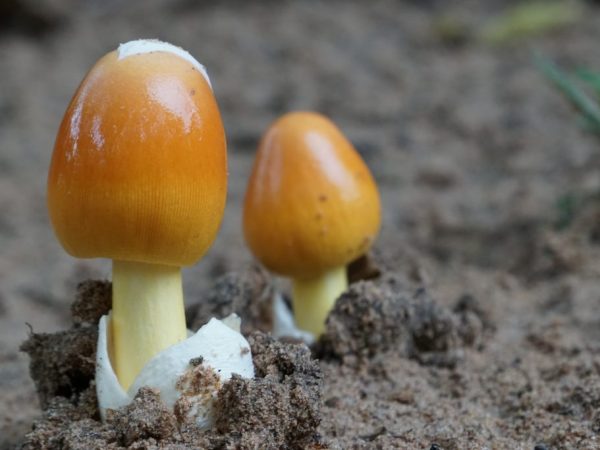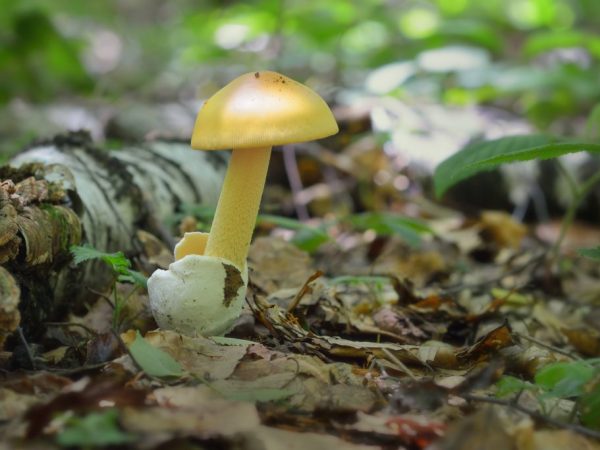Pusher mushrooms
Floats (pusher mushrooms) are a species that is theoretically considered edible. It does not have a high nutritional value and belongs to the genus Amanita. These are unattractive specimens both in appearance and in taste.

Pusher mushrooms
Appearance
The pusher (Amanitopsis alba), according to the description, has a leg 0.8-1.2 cm in diameter, 5-15 cm high. The color is white or gray. Mushrooms of the type of saffron floats (Amanita crocea) differ from the gray floats (Amanita vaginata) in the color of the cap.
The surface of the cap in different types of mushroom float has a variety of colors: gray, yellow, orange. The hat of an adult individual reaches 4-9 cm in diameter. In the young it is bell-shaped, in adults it is already flat, and occasionally flat-convex.
The hymenophore plates of the floats are white, free and frequent. The spore powder is also white. Spores in the form of a ball, non-amyloid, their surface is smooth.
Irina Selyutina (Biologist):
Scars are clearly visible along the edges of the cap - traces of attachment of plates and plates from its lower side. On the surface of the cap there may be flakes that are easily separated from the skin - filmy or similar in appearance to warts.
The leg of the floats (pushers) can be either naked or covered with a flaky bloom, or have a pattern of thin (to match its surface) scales. Despite the fact that the mushrooms belong to the fly agaric, at the base, the leg does not have a tuberous swelling and is easily separated from the cap.
The lower part of the leg is immersed in a well-developed volva, which, in turn, is located quite deep in the soil. But with age, the Volvo can sometimes disappear. There is usually no ring on the leg.
The float mushroom is similar to the fly agaric even in chemical composition, but some scientists refuse to consider them related species.

The height of the mushroom leg is 5-15 cm, the diameter of the cap is 4-9 cm
Views
The gray float mushroom is an edible species. It is noticeable due to the gray color of the fragile cap 4-8 cm in diameter. Its central part is a darker, more saturated shade. It has an ovate-bell-shaped shape, sometimes flat. The edge is ribbed along the entire circumference. Leg 5-12 cm high. Colors - white, beige, gray. The plates are white and loose. These mushrooms grow in late summer and early autumn, singly or in large quantities at a short distance.
There is a possibility of meeting the following types:
- Float (pusher) yellow-brown: he has an unusual hat color. Its edges are white, changing towards the center from brown, orange shades to dark, almost black in the central part.
- Saffron float (pusher): it is distinguished by a saffron and orange hat, which has a dark color in the central part. The leg also has this shade. The plates are often yellow. They grow rarely, primarily in swampy areas (one by one and in groups).
- The float (pusher) is umber yellow (Battarra's fly agaric): in the central part of the cap are dark in color, while the edges are yellow or brown. The leg also has this shade. There are small scales on it.
- Float (pusher) white: representatives of this species are the owners of a leg with pale scales, on which there is an ovoid or flat cap with a small tubercle in the central part. Its size reaches 10 cm in diameter. The pulp is white, but fragile and crumbles quickly. This species grows in mixed and deciduous forests, near birches.
- Float (pusher) snow-white: perhaps the smallest species. Its leg is 7-10 cm high, and the cap is 3-7 cm in diameter. Young individuals have flakes covering the surface of the cap. Over time, they disappear, the shade of the leg also changes: white becomes gray.
Beneficial features
Pushers are nutritious. They have special biologically active components called betaines. Betaines are beneficial for humans, since they affect the metabolic process in the body. The composition is similar to that of the float and porcini mushroom.
Pushers contain many vitamins, especially of group B, and other trace elements, as well as in other edible fly agaric species.

Pushers are nutritious and healthy
Contraindications
This species does not pose a danger to human life and health. According to the description, it looks like a pale toadstool, so there is a great risk of confusing these mushrooms. In this case, intoxication of the body will occur. It is also possible to get poisoned from the float if it was collected near industrial zones or a road: it quickly absorbs toxic substances from the environment.
It is not necessary to eat the mushroom for a number of diseases:
- diabetes;
- poor kidney and liver function;
- hypertension.
The fungus is excluded from the diet if there are allergic reactions to this particular species.
Application
The float is unattractive in appearance, tastes bland, with bitterness, so it is not particularly popular among mushroom pickers. Collecting, transporting, processing and cooking with this species is not easy: the structure of the mushroom is fragile and brittle. Moreover, it is extremely popular in dietary nutrition.
In cooking
The float is used in cooking after pre-cooking. It is great for drying. Amanitopsis is used for cooking first and second courses, snacks.
The process of cooking pushers does not differ from other types of cooking. To begin with, they are delicately cleaned of dirt and rinsed abundantly with water. The next step is to cook for about an hour. It is possible to salt or marinate Amanitopsis without resorting to soaking or scalding in advance.
In medicine
This species of the genus Amanita contains a lot of betaine. In medicine, this chemical compound is used to fight Alzheimer's disease, breast cancer, prostate adenoma, liver, kidney and gallbladder diseases.
Conclusion
Pushers, or floats, are fragile and brittle mushrooms that require delicacy. It is important to be very careful when picking these edible mushrooms.



